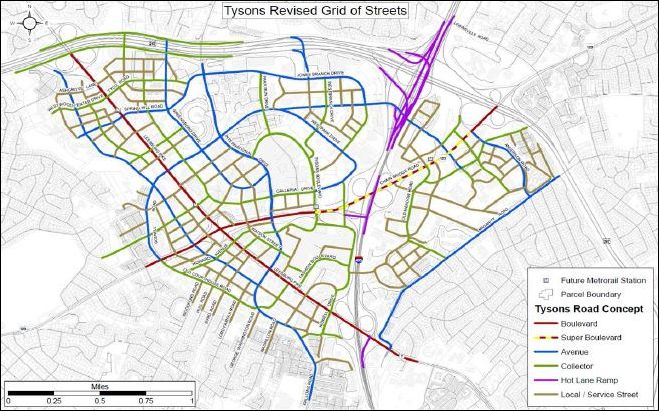by James A. Bacon
Transforming Tysons in Fairfax County from an “edge city” into a walkable, mixed-use urban district may be the biggest, most ambitious suburban makeover ever attempted. Anywhere. In the history of the human race.
The obstacles are formidable. The area grew up in such a helter skelter manner, and the layout of streets, buildings and parking lots are so thoroughly auto-centric in design, that Tysons’ built environment will have to be rebuilt from stem to stern. The cost of creating a street grid and providing transportation connections in and out of the district will run into the billions of dollars. It’s not clear where the public dollars are coming from. And it’s not clear either, given Northern Virginia’s current overbuilt office environment, whether the private dollars will be forthcoming any time soon.
But Fairfax County and Virginia are plunging ahead with the decades-long effort. In a presentation to the Tysons Citizens Coalition two weeks ago, Tom Biesiadny, director of Fairfax County’s department of tranpsportation, gave a recap of where things stand. I did not attend the meeting, so I did not hear Biesiadny’s remarks, but a long-time friend of Bacon’s Rebellion who goes by the pen name of Too Many Taxes shared the presentation with me. While the numbers come from Biesiadny, the commentary that follows is mine.
Existing development consists of 48.6 million square feet of mostly commercial office space, with some retail and a smidgen of housing thrown in. Another 2.8 million square feet is under construction, with 45 million square approved or proposed. The street grid won’t be built until landowners begin re-developing their properties and completing their links in the grid.
Tysons is caught in a Catch 22. The real estate market is moving towards walkable urbanism, but Tysons has little walkable urbanism to offer. While developers can create small islands of mixed-use walkability, the fundamental character of the district won’t change until a critical mass has been attained. Until that critical mass is attained, Tysons will suffer a competitive disadvantage with downtown Washington, Arlington, Alexandria and other locations where the walkable, mixed-use fabric is already in place.
Planners are counting upon completion of the first phase of the Silver Line spur on the Washington metro to jump start the development. However, at present, Silver Line ridership averages around 16,000 boardings per day, according to Biesiadny. After nearly a year since the Silver Line opened, ridership falls far short of the 46,000 forecast made as recently as 2013 in the Washington Metropolitan Area Transit Authority’s marketing plan. (Update: I have been told that comparing 16,000 boardings to 46,000 total riders is comparing apples and oranges. Sixteen thousand boardings translates into 32,000 trips, or riders. Thus, ridership has fallen short of projections but not by as grievous a margin as implied.)
Other parts of the plan appear to be unfolding on schedule. Six major road projects are in the works. Farthest along is a Route 7 bridge over the Dulles Toll Road, for which a design-build contract has been approved. Funding has been approved for a widening of Route 7. Four other projects are in various phases of study and design.
Meanwhile, Fairfax County is working on Tysons’ bicycle and pedestrian connections. Twelve projects have been completed, nine are under design, nine are in the land-acquisition phase and five are under construction. A Virginia Department of Transportation repaving project will add eight miles of bike facilities this summer.
Also of note, the Tysons Partnership has developed a transportation demand management program that will provide services to property owners on a subscription basis. Services include trip reduction strategies, ride-matching assistance, telework support, transit incentives and monitoring of travel behaviors. So far, eight companies have signed up.
Bacon’s bottom line: My reading of this presentation is that Fairfax County is doing all the right things but the Tysons makeover still has a long, hard climb ahead of it. We may not see much visible progress until the Northern Virginia commercial real estate market rebounds strongly, vacancies fall and developers have an incentive to start building again. But I’ll be the first to admit that I’m not close to the situation and my interpretation could be all wrong.



